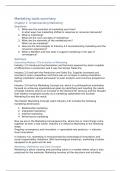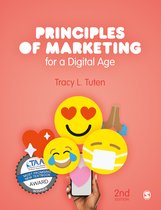Marketing tools summary
Chapter 1: Understanding Marketing
Questions
1. What was the evolution of marketing over time?
In what ways has marketing shifted in response to consumer demands?
2. What is marketing?
What are the core concepts of marketing?
3. What are the elements of the marketing mix?
What can be marketed?
4. How are the technologies of Industry 4.0 revolutionizing marketing and the
consumer experience?
5. What is MarTech and how does it support marketing in the age of
convergence?
Summary
Everything Matters: The Evolution of Marketing
Industry 1.0 introduced mechanization and factories powered by steam capable
of efficiencies in production and it was the Simple Trade Era.
Industry 2.0 had both the Production and Sales Era. Supplies increased and
resulted in more competition and there was an increase in selling orientation.
Selling orientation valued persuasion to push products and convince prospective
buyers.
Industry 3.0 had the Marketing Concept era, which is a philosophical orientation
focused on achieving organizational goals by identifying and meeting the needs
of target markets. Due to an increase in the demand for services and the thought
that leaders recognized society as a marketing stakeholder the Societal
Marketing Era was the result.
The Holistic Marketing Concept (start Industry 4.0) includes the following
marketing dimensions:
1. Relationship marketing
2. Integrated marketing
3. Internal marketing
4. Performance marketing
Now we are in the Marketing Convergence Era, where two or more things come
together to form a new whole. Industry 4.0 influence Marketing in the following
steps:
Ongoing convergence and innovation -> generated new products -> industry-
level innovations
In Industry 4.0, marketing is revolutionized by technological innovations and
social responsibility initiatives. With technological advances, marketing is better
equipped to do good and do well.
Marketing: Definitions and Core Concepts
Marketing is about creating and providing value in a market where value is also
produced for the marketer. Marketing involves all the decisions and activities
,related to bringing an offer to a market of prospective buyers and successfully
selling the offer to customers.
A market is the aggregate of all prospects and customers with an unmet need
and the ability to buy. Markets can be identified in many different ways. The main
ones of market based on type of seller and buyer are the following:
- C2C: Consumer-to-Consumer
- C2B: Consumer-to-Business
Example: freelancers who provide services to business clients
- B2C: Business-to-Consumer
Targeting households, utilization of traditional shopping venues and e-
commerce
- B2B: Business-to-Business
Products needed for business and professional use (government included)
Vertical markets: one specific industry segment (healthcare)
Horizontal markets: products valued across range of different industries
(office eq.)
Platforms is a market that resulted from technological and marketing
convergence. Platforms make resources and participants more accessible to each
other on an as-needed basis. Platforms are multi-sided markets, but grow
popularity in facilitating C2C transactions. (Etsy)
Exchange is a transfer of value between buyer and seller, because customers
want to fulfil their needs and wants. Marketing helps to create a customer and an
exchange. The Hierarchy of Needs by Maslow shows both the individual and
organizational needs in a hierarchy. Unmet needs motivate behaviour is the key
principle to resolve the gap between actual and desired state, which is why
understanding needs and motives of buyers is a marketing core competency.
Products are meant to benefit customers by providing utilities that meet
customer needs. There are five forms of utility:
- Form utility: value created by producing a product useful for meeting
market needs
- Time utility: value of making product available when needed
- Place utility: value of making product available for purchase via a channel
where customers can buy it
- Possession utility: exchange of money for product, possession provides
value by meeting need
- Information utility: value provided by communicating with prospects and
customers
The Offer and the Marketing Mix
The Marketing Mix includes the 4 P’s:
o Product (entity offered for sale, core benefit)
Theodore Levit: all products are customers asked, buy promises that the
needs will be satisfied
o Price (assignment of value required for an exchange to occur)
o Place (channel of distribution used to make product available for purchase)
o Promotion (all activities and communication channels marketers use to
communicate)
,The Marketing Mix is expanded with 3 P’s to accommodate services:
o People (influence of service providers on customer experiences and
outcomes)
o Process (influence of process design on customer experience and outcome)
o Presence (building environments of sensory cues to influence customers)
Industry 4.0 and the Era of Marketing Convergence
The Internet of Everything (IoE) consists of four elements:
- Internet of Things: it refers to physical objects capable of connecting to the
Internet and communicating and analysing data and communication
IoT gateways attached to any object, making it smart (RFID tags)
- Internet of People: people connect through networked devices and social
networks
- Internet of Data: it refers to the data produced, captured and processed
where and when it is needed to inform decisions
Data generated declared (voluntary reported) or inferred (predictive
analytics)
- Process: management, analysis, communication and application of data
Cloud computing (storing & accessing data), edge computing (processing
data close to source)
Digital reality utilizes data from sensors and cameras to create presentations
including visual and auditory elements in which users can interact using gestures
and voice commands. There are four different kinds of digital reality:
o Augmented Reality (AR): digital content overlayed on an actual, real
environment
o Virtual Reality (VR): immersing user in artificial, digital environment
o Mixed Reality (MR): generates new environment with digital and physical
objects
o 360-degree video: capturing and presenting video imagery 360 degrees
around users
Cognitive technologies do the things that traditionally required human
intelligence, including reasoning and learning. This is used marketing to predict
consumer purchases, recognize fraudulent credit card activity and automate
personal ads. These are several types of cognitive technologies:
o Artificial Intelligence
o Machine learning: set of statistical techniques that automate analytical
model-building using algorithms that learn from data without the need for
explicit programming
o Robotic automation: combining AI and automation to process data and
automate processes
o Language processing: statistical techniques that enable the analysis,
understanding and generating of human languages
A blockchain is a database of transactions and record replicated in real-time
across a network of computers. A blockchain database links to all previous blocks
and maintains a complete history of all assets and instructions executed since
, the first one. Blockchain data is secure, verifiable and independently auditable.
(Bitcoin)
Additive manufacturing is a process by which digital 3D design data is used to
build up a component in layers by depositing material. It embraces the use of
digital twins to simulate the physical world. A digital twin is a digital model of a
physical process, object or environment built on historical data and with data
sensors and cognitive technologies capable of learning and evolving. It is now
possible to create ‘digital twins’ of customers, and the application of this is called
object marketing.
Big data is defined by three properties, volume (amount of data), variety (number
of types of data) and velocity (speed of data processing). The Big Data Life Cycle
includes four phases:
1. Collection: little bits of data are collected about individuals from a variety
of sources
2. Compilation and Consolidation: ‘little’ data is compiled and consolidated
into ‘big’ data by data brokers (build profiles about individual consumers)
also includes “acquisition” of data.
3. Data Mining and Analytics: “big” data is analysed to uncover patterns of
past behaviour and predict future consumer behaviour
4. Use: using end analysis to drive insights, develop new products, automate
marketing tasks
We are willingly sharing information to feed big data algorithms. Big data sets are
made up of data collected from the following:
o Active data: human behaviour and human data submissions
generated when user chooses to submit information (activity online)
o Traditional data sources from the organizational records of public agencies
and businesses
o Machine data, recorded and collected as a by-product of the use of
machines
o Metadata, data about data
The European Union developed the General Data Protection Regulation (GDPR) to
specify proper data protection measures and rules organizations must follow.
All the technologies relate to the Web 3.0, which refers to the ability of computing
machines to interact in a human manner.
Marketing applications of Industry 4.0 technologies: MarTech
Many marketing applications incorporate hardware, software and data ways that
cross categories of technologies. The customer care is changing through living
services, which predicts and supports customer needs for service, repair and
maintenance. Living services use IoE, cognitive technologies and digital realities.
The combination of marketing and digital technology is known as MarTech.
MarTech accounts for the largest portion of marketing budgets at 26.2% and the
field of MarTech has grown rapidly in the recent years. These are the MarTech
categories that are currently used within Marketing:
- Advertising/promotion






